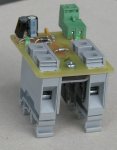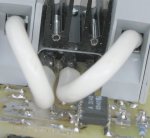I just realised after re-reading my post that I may have caused confusion.
When referring to currents I was meaning the brief large currents involved with driving the GATE of the MOSFET not the device load of whatever you are switching.
So many people think that 'driving' just means shoving in, but it also means sucking out.
Some of the larger MOSFETs will have thousands of pFs which means a healthy charge you have to get out from and put in to the Gate to switch it quickly. So, long thin tracks from Driver to Gate should be avoided.
AND read about the recommended capacitance that should be used as the Driver bypass. Remember, it will be briefly discharging / charging currents in the amps range, so a healthy low-impedance 'reservoir' is needed that performs well at VHFs.
The TC4422 recommends 1uF ceramic capcitor as the bypass. Whereas a lower power handling driver may only require 100nF ceramic. A bit cheaper and quite capable of driving 30 Amp rated MOSFETs.
For anyone else interested: when selecting a driver remember devices like the TC4422 are non-inverting type for easy PWM driving of N Channel MOSFETs and the TC4421 are inverting for driving P Chan MOSFETs.
The LMD18200 looks nice for small apps and obv hasall the nitty-gritty on-board so is a different thing. But, whatever power item you are using, be generous with power/ground tracks. Don't skimp just to save ink/laser-toner



